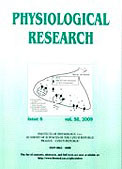Vernerova Z, Kujal P, Kramer HJ, Backer A, Cervenka L, Vaneckova I. Physiol. Res. 58 (suppl. 2): S69–S78, 2009. IF: 1.653

Abstract:
The rat strain transgenic for the murine Ren-2 renin gene (TGR) is defined as a monogenic model of angiotensin II-dependent hypertension with endogenous activation of the renin-angiotensin system. Homozygous males TGR develop malignant hypertension with a strong salt-sensitive component. These animals show severe hypertension, proteinuria and high mortality. Morphological changes of renal parenchyma correspond to chronic ischemic glomerular changes. Heterozygous TGR develop only mild hypertension and thus provide a more suitable model of hypertension regarding to clinical studies. Within the renal parenchyma, secondary focal segmental glomerulosclerosis (FSGS) predominates. High-salt diet in heterozygous animals induces transition from benign to malignant phase of hypertension. In this case, ischemic glomerular changes are superimposed on preexisting secondary FSGS. In the regression model of hypertension (late-onset treatment) the effect of salt intake is attenuated. In homozygous TGR, early selective ETA receptor blockade decreased blood pressure and ameliorated end-organ damage. Late selective ETA receptor blockade reduced podocyte injury despite final severe hypertension. Survival rate was markedly improved in both regimens with ETA selective blockade, while there was only partial improvement with early non-selective blockade. Both bosentan and atrasentan decreased ET-1 levels in both regimens. In heterozygous TGR, early and late ETA treatment substantially while ETA/ETB treatment partially improved survival rate. Significant effect on BP was found with early and late ETA blockade, while ETA/ETB blockade had no effect. Bosentan and atrasentan similarly decreased ET-1 levels on both regimens. In conclusion, selective ETA receptor blockade is superior to nonselective ETA/ETB receptor blockade in attenuating hypertension and end-organ damage. Its effect is more pronounced when applied early in the life.
-mk-
